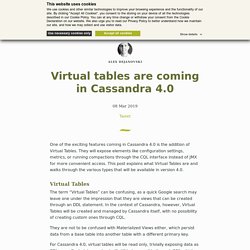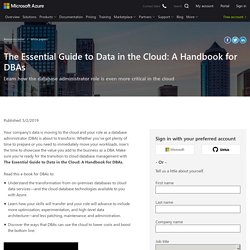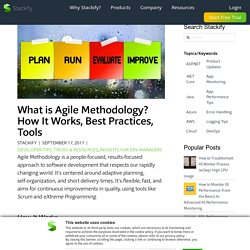

Intro to Cassandra for Developers Workshop [NAM Time] Courses and scenarios authored by DataStax. DataStax-Academy/Intro-to-Cassandra-for-Developers. Virtual tables are coming in Cassandra 4.0. One of the exciting features coming in Cassandra 4.0 is the addition of Virtual Tables.

They will expose elements like configuration settings, metrics, or running compactions through the CQL interface instead of JMX for more convenient access. This post explains what Virtual Tables are and walks through the various types that will be available in version 4.0. Virtual Tables The term “Virtual Tables” can be confusing, as a quick Google search may leave one under the impression that they are views that can be created through an DDL statement.
In the context of Cassandra, however, Virtual Tables will be created and managed by Cassandra itself, with no possibility of creating custom ones through CQL. They are not to be confused with Materialized Views either, which persist data from a base table into another table with a different primary key. For Cassandra 4.0, virtual tables will be read only, trivially exposing data as CQL rows. The tables themselves can be described as shown here: Brianmhess/cassandra-count: Count rows in Cassandra Table. Cassandra: The Definitive Guide - 3rd Edition. 365 Developer Program FAQ. Learn PowerShell from basics to a coding star – free courses.
Microsoft - OneDrive Dev Center - Docs. Microsoft Azure IAM Quickstart Guides. Microsoft Azure App list. Authentication in Microsoft identity platform. Cloud migration essentials. Introducing Microsoft SQL Server 2019 E-book. Data in the Cloud DBA Handbook. Your company’s data is moving to the cloud and your role as a database administrator (DBA) is about to transform.

Whether you’ve got plenty of time to prepare or you need to immediately move your workloads, now’s the time to showcase the value you add to the business as a DBA. Make sure you’re ready for the transition to cloud database management with The Essential Guide to Data in the Cloud: A Handbook for DBAs. Read this e-book for DBAs to: Understand the transformation from on-premises databases to cloud data services—and the cloud database technologies available to you with Azure.Learn how your skills will transfer and your role will advance to include more optimization, experimentation, and high-level data architecture—and less patching, maintenance, and administration.Discover the ways that DBAs can use the cloud to lower costs and boost the bottom line.
Your company’s data is moving to the cloud and your role as a database administrator (DBA) is about to transform. What is Agile Methodology? Tools, Best Practices & More. Agile Methodology is a people-focused, results-focused approach to software development that respects our rapidly changing world.

It’s centered around adaptive planning, self-organization, and short delivery times. It’s flexible, fast, and aims for continuous improvements in quality, using tools like Scrum and eXtreme Programming. How It Works It works by first admitting that the old “waterfall” method of software development leaves a lot to be desired. The process of “plan, design, build, test, deliver,” works okay for making cars or buildings but not as well for creating software systems. Agile Methodology Overview It abandons the risk of spending months or years on a process that ultimately fails because of some small mistake in an early phase. Faster, smaller. For training purposes, there’s a comprehensive, downloadable overview here. Examples of Agile Methodology Scrum is a hands-on system consisting of simple interlocking steps and components: Image via Open-Ware.org Faster.
Zeit.co (now.sh)
Html5 - HTML 5: Is it <br>, <br/>, or <br />? #dailyui 007: Settings. Learn CSS Layout - floats, positioning, flexbox, grids. How I built a Slack bot to help me find an apartment in San Francisco. A Hash Function for Hash Table Lookup. Abstract I offer you a new hash function for hash table lookup that is faster and more thorough than the one you are using now.

I also give you a way to verify that it is more thorough. All the text in this color wasn't in the 1997 Dr Dobbs article. The code given here are all public domain. The Hash Over the past two years I've built a general hash function for hash table lookup. These old hashes defined my requirements: The keys are unaligned variable-length byte arrays. Without further ado, here's the fastest hash I've been able to design that meets all the requirements.
Update: I'm leaving the old hash in the text below, but it's obsolete, I have faster and more thorough hashes now Most hashes can be modeled like this: initialize(internal state) for (each text block) { combine(internal state, text block); mix(internal state); } return postprocess(internal state); In the new hash, mix() takes 3n of the 6n+35 instructions needed to hash n bytes. Three tricks promote speed: A common weakness. Datapipe gitlabs (login)